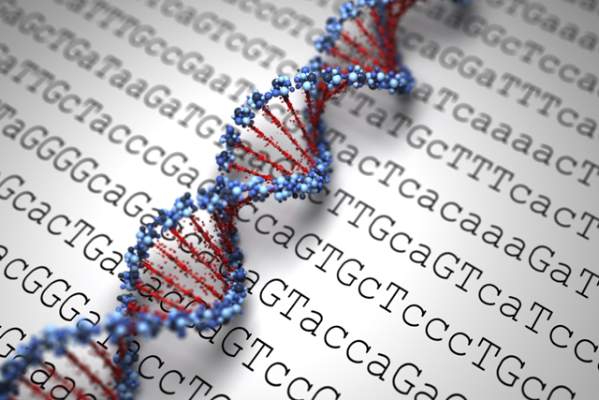User login
A genome-wide association study uncovered two new genetic risk variants for alcohol-related liver cirrhosis and confirmed a third previously identified susceptibility locus, researchers reported online Oct. 16 in Nature Genetics.
The new variants affect the MBOAT7 and TM6SF2 genes, while the third is rs738409, a single-nucleotide polymorphism of the PNPLA3 gene that was previously implicated in nonalcoholic fatty liver disease (NAFLD). “These three loci have a role in lipid processing, suggesting that lipid turnover is important in the pathogenesis of alcohol-related cirrhosis,” said Dr. Stephan Buch of the Dresden (Germany) University of Technology and his associates.
Most heavy drinkers develop hepatic steatosis (fatty liver), but a minority ultimately progress to cirrhosis. To assess genetic risk factors for alcohol-related cirrhosis, the researchers compared genome-wide association data for 712 cirrhotic alcoholics in Belgium, the United Kingdom, and Germany with 1,426 alcohol misusers from these countries who did not have cirrhosis. They validated the results in two separate cohorts of 1,148 cirrhotic alcoholics (cases) and 2,315 noncirrhotic alcoholic controls (Nat. Genet. 2015 Oct. 16. doi: 10.1038/ng.3417).
Variants in MBOAT7 and TM6SF2 significantly increased the risk of alcohol-related cirrhosis (P = 1.03 × 10-9 and 7.89 × 10-10, respectively), the investigators found. The rs738409 SNP in the PNPLA3 gene also was an important risk factor for alcohol-related cirrhosis (P = 1.54 × 10-48), as it is in NAFLD, added the researchers. Variants in both PNPLA3 and TM6SF2 have been linked to increased intrahepatic fat and potential loss of liver function. “Thus, we hypothesize that the genetic variants in these loci confer risk via dysfunctional lipid turnover,” they wrote.
Overlapping results from this study of alcohol-related cirrhosis and the prior genome-wide association study of NAFLD indicate that the two conditions might have similar pathogeneses, and that therapies targeting these genes might improve outcomes in both disorders. “The variants at the three identified loci may also help to define high-risk populations for targeted abstinence intervention and hepatic surveillance programs,” they concluded.
The investigators reported many funding sources, including the Germany Ministry of Education and Research, PopGen 2.0 network biobank, TU Dresden, Christian Albrechts University Kiel, Swiss National Funds, Ministry of Cultural Affairs, Social Ministry of the Federal State of Mecklenburg–West Pomerania, European Union, EFRE–State Ministry of Economics, Deutsche Krebshilfe, DFG Excellence Cluster 306, Foundation for Experimental Medicine (Switzerland), University College London, the Belgian Federal Science Policy Office, and the Fund for Scientific Research. The researchers declared no competing financial interests.
A genome-wide association study uncovered two new genetic risk variants for alcohol-related liver cirrhosis and confirmed a third previously identified susceptibility locus, researchers reported online Oct. 16 in Nature Genetics.
The new variants affect the MBOAT7 and TM6SF2 genes, while the third is rs738409, a single-nucleotide polymorphism of the PNPLA3 gene that was previously implicated in nonalcoholic fatty liver disease (NAFLD). “These three loci have a role in lipid processing, suggesting that lipid turnover is important in the pathogenesis of alcohol-related cirrhosis,” said Dr. Stephan Buch of the Dresden (Germany) University of Technology and his associates.
Most heavy drinkers develop hepatic steatosis (fatty liver), but a minority ultimately progress to cirrhosis. To assess genetic risk factors for alcohol-related cirrhosis, the researchers compared genome-wide association data for 712 cirrhotic alcoholics in Belgium, the United Kingdom, and Germany with 1,426 alcohol misusers from these countries who did not have cirrhosis. They validated the results in two separate cohorts of 1,148 cirrhotic alcoholics (cases) and 2,315 noncirrhotic alcoholic controls (Nat. Genet. 2015 Oct. 16. doi: 10.1038/ng.3417).
Variants in MBOAT7 and TM6SF2 significantly increased the risk of alcohol-related cirrhosis (P = 1.03 × 10-9 and 7.89 × 10-10, respectively), the investigators found. The rs738409 SNP in the PNPLA3 gene also was an important risk factor for alcohol-related cirrhosis (P = 1.54 × 10-48), as it is in NAFLD, added the researchers. Variants in both PNPLA3 and TM6SF2 have been linked to increased intrahepatic fat and potential loss of liver function. “Thus, we hypothesize that the genetic variants in these loci confer risk via dysfunctional lipid turnover,” they wrote.
Overlapping results from this study of alcohol-related cirrhosis and the prior genome-wide association study of NAFLD indicate that the two conditions might have similar pathogeneses, and that therapies targeting these genes might improve outcomes in both disorders. “The variants at the three identified loci may also help to define high-risk populations for targeted abstinence intervention and hepatic surveillance programs,” they concluded.
The investigators reported many funding sources, including the Germany Ministry of Education and Research, PopGen 2.0 network biobank, TU Dresden, Christian Albrechts University Kiel, Swiss National Funds, Ministry of Cultural Affairs, Social Ministry of the Federal State of Mecklenburg–West Pomerania, European Union, EFRE–State Ministry of Economics, Deutsche Krebshilfe, DFG Excellence Cluster 306, Foundation for Experimental Medicine (Switzerland), University College London, the Belgian Federal Science Policy Office, and the Fund for Scientific Research. The researchers declared no competing financial interests.
A genome-wide association study uncovered two new genetic risk variants for alcohol-related liver cirrhosis and confirmed a third previously identified susceptibility locus, researchers reported online Oct. 16 in Nature Genetics.
The new variants affect the MBOAT7 and TM6SF2 genes, while the third is rs738409, a single-nucleotide polymorphism of the PNPLA3 gene that was previously implicated in nonalcoholic fatty liver disease (NAFLD). “These three loci have a role in lipid processing, suggesting that lipid turnover is important in the pathogenesis of alcohol-related cirrhosis,” said Dr. Stephan Buch of the Dresden (Germany) University of Technology and his associates.
Most heavy drinkers develop hepatic steatosis (fatty liver), but a minority ultimately progress to cirrhosis. To assess genetic risk factors for alcohol-related cirrhosis, the researchers compared genome-wide association data for 712 cirrhotic alcoholics in Belgium, the United Kingdom, and Germany with 1,426 alcohol misusers from these countries who did not have cirrhosis. They validated the results in two separate cohorts of 1,148 cirrhotic alcoholics (cases) and 2,315 noncirrhotic alcoholic controls (Nat. Genet. 2015 Oct. 16. doi: 10.1038/ng.3417).
Variants in MBOAT7 and TM6SF2 significantly increased the risk of alcohol-related cirrhosis (P = 1.03 × 10-9 and 7.89 × 10-10, respectively), the investigators found. The rs738409 SNP in the PNPLA3 gene also was an important risk factor for alcohol-related cirrhosis (P = 1.54 × 10-48), as it is in NAFLD, added the researchers. Variants in both PNPLA3 and TM6SF2 have been linked to increased intrahepatic fat and potential loss of liver function. “Thus, we hypothesize that the genetic variants in these loci confer risk via dysfunctional lipid turnover,” they wrote.
Overlapping results from this study of alcohol-related cirrhosis and the prior genome-wide association study of NAFLD indicate that the two conditions might have similar pathogeneses, and that therapies targeting these genes might improve outcomes in both disorders. “The variants at the three identified loci may also help to define high-risk populations for targeted abstinence intervention and hepatic surveillance programs,” they concluded.
The investigators reported many funding sources, including the Germany Ministry of Education and Research, PopGen 2.0 network biobank, TU Dresden, Christian Albrechts University Kiel, Swiss National Funds, Ministry of Cultural Affairs, Social Ministry of the Federal State of Mecklenburg–West Pomerania, European Union, EFRE–State Ministry of Economics, Deutsche Krebshilfe, DFG Excellence Cluster 306, Foundation for Experimental Medicine (Switzerland), University College London, the Belgian Federal Science Policy Office, and the Fund for Scientific Research. The researchers declared no competing financial interests.
FROM NATURE GENETICS
Key clinical point: A genome-wide association study identified two new gene variants and confirmed a third as risk factors for alcohol-related cirrhosis.
Major finding: Variants in MBOAT7 and TM6SF2 significantly increased the risk of alcohol-related cirrhosis (P = 1.03 × 10-9 and 7.89 × 10-10, respectively). A single-nucleotide polymorphism (rs738409) in the PNPLA3 gene also was implicated (P = 1.54 × 10-48), as it has been in non–alcohol-related fatty liver disease.
Data source: Genome-wide association case-control study of 2,138 individuals of European descent.
Disclosures: The investigators reported many funding sources, including the Germany Ministry of Education and Research, PopGen 2.0 network biobank, TU Dresden, Christian Albrechts University Kiel, Swiss National Funds, Ministry of Cultural Affairs, Social Ministry of the Federal State of Mecklenburg–West Pomerania, European Union, EFRE–State Ministry of Economics, Deutsche Krebshilfe, DFG Excellence Cluster 306, Foundation for Ex-perimental Medicine (Switzerland), University College London, the Belgian Federal Science Policy Office, and the Fund for Scientific Research. The researchers declared no competing financial interests.

